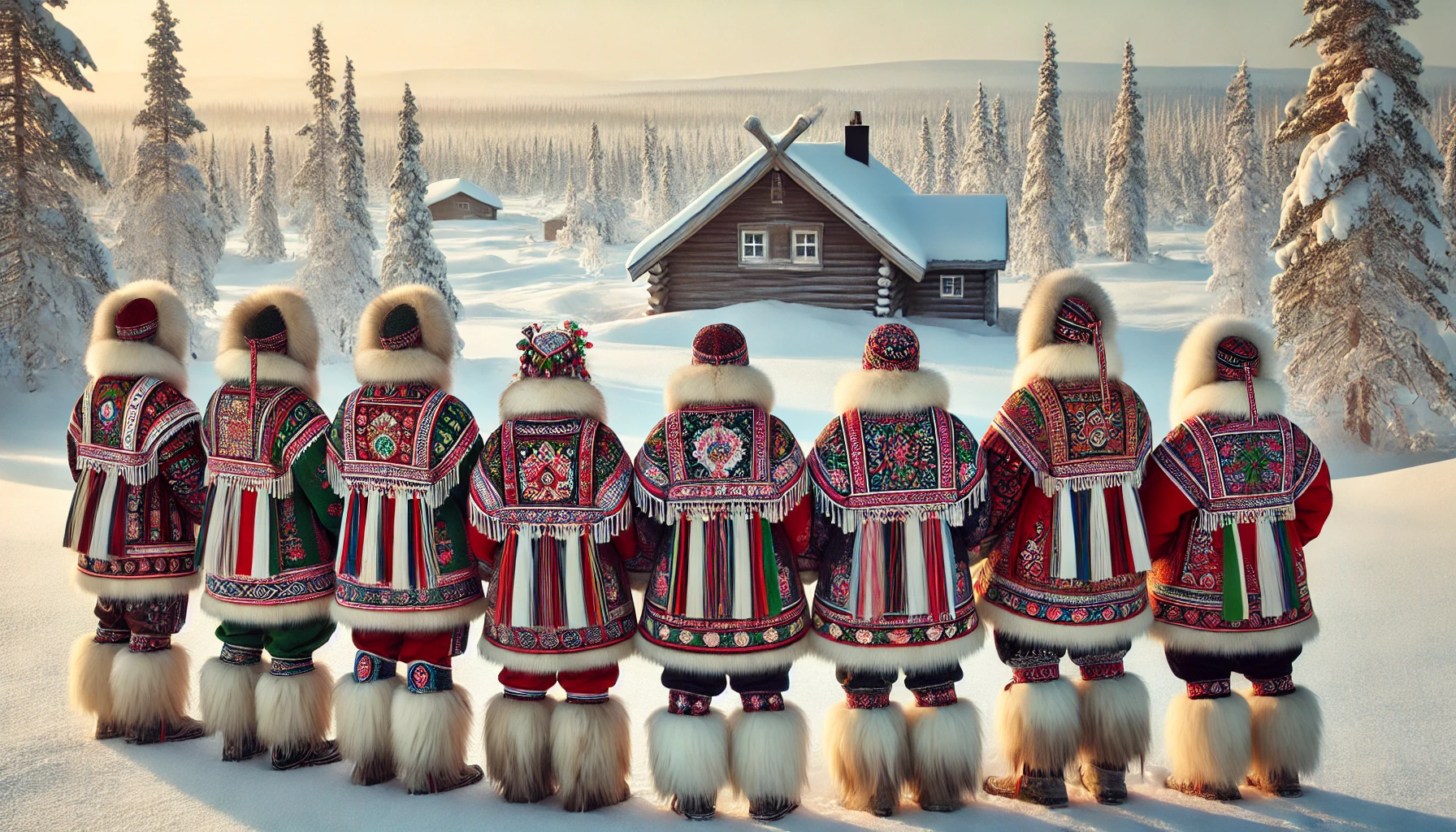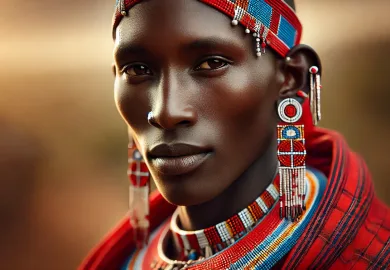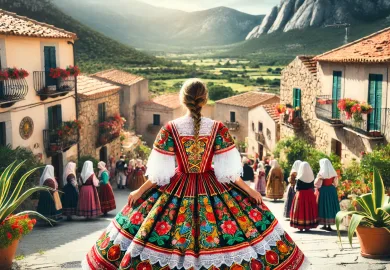
Disclaimer: This content was generated using AI. While I strive for accuracy, I encourage readers to verify important information. I use AI-generated content to increase efficiencies and to provide certain insights, but it may not reflect human expertise or opinions.
The Sámi people, indigenous to the northern regions of Norway, Sweden, Finland, and Russia, have a rich and distinct cultural heritage. A cornerstone of this heritage is their traditional clothing, known as the gákti. Worn by the Sámi for centuries, this attire is not only a form of self-expression but also a reflection of their deep connection with the Arctic environment. In Lapland, the heartland of the Sámi people, these garments are a symbol of identity, history, and resilience. Let’s explore the beautiful intricacies of traditional Sámi clothing, the significance behind its design, and its role in the modern world.
The Significance of the Gákti in Sámi Culture
The gákti is more than just clothing for the Sámi people; it is a crucial part of their cultural identity. Traditionally worn on special occasions such as festivals, weddings, and religious ceremonies, the gákti also reflects one’s family background, marital status, and geographic origin. The vibrant colors, unique patterns, and carefully selected materials that make up the gákti tell a story of the Sámi’s connection to their land and their rich cultural history.
The design of the gákti often varies based on region, and even within families, there can be subtle differences that showcase unique heritage. For example, Sámi people from coastal regions may wear gákti adorned with silver jewelry, while those from inland areas may incorporate more natural elements like reindeer fur or leather. The patterns and colors—most often red, blue, yellow, and green—are often symbolic. Red, for instance, is frequently associated with life, warmth, and protection in Sámi culture.
Beyond aesthetics, the gákti is also practical, designed to protect the wearer from the harsh Arctic climate. The materials used, such as wool, leather, and reindeer fur, provide insulation and durability, essential for surviving the long, cold winters of Lapland. Today, while modern clothing is more commonly worn in daily life, the gákti remains a treasured part of Sámi tradition, proudly worn during cultural events and festivals.
The Craftsmanship and Design of Sámi Attire
Sámi clothing is meticulously handcrafted, with each garment often taking weeks or even months to complete. The creation of a gákti involves several traditional techniques passed down through generations, ensuring that each piece is not only beautiful but also durable enough to withstand the rugged conditions of the Arctic. Embroidery, weaving, and beadwork are commonly used to add decorative elements to the garments, with each detail carrying symbolic meaning.
The gákti is typically made from wool, cotton, or linen, and is adorned with intricate embroidery, ribbons, and silver buttons or brooches known as solju. The solju is an important part of the gákti, often worn at the neck, and is believed to protect the wearer from evil spirits. It is also a mark of social status, with more elaborate solju indicating higher prestige within the community.
Another iconic element of Sámi clothing is the four-cornered hat, or čiehgahpir, worn by men. This hat, often seen in vibrant colors, represents the four cardinal directions, symbolizing the Sámi’s deep connection to nature and the land. Women, on the other hand, may wear shawls or scarves as part of their traditional attire, adding an additional layer of warmth and elegance to the outfit. These accessories are often made from fine fabrics like silk and are adorned with fringe, lace, or silver ornaments.
Sámi Footwear: A Blend of Functionality and Tradition
Footwear is an essential aspect of Sámi clothing, particularly because of the harsh, snow-covered terrain in Lapland. The traditional footwear worn by the Sámi is known as nutukas or gámpas, both of which are crafted from reindeer hide. These shoes are designed to keep the feet warm and dry in freezing temperatures, making them an indispensable part of Sámi winter attire.
Reindeer boots, or gápmagat, are perhaps the most iconic piece of Sámi footwear. These boots are not only functional but are also deeply symbolic, reflecting the importance of reindeer herding in Sámi culture. Reindeer fur is used for insulation, and the boots are often tied with bands of colorful wool to ensure a snug fit. The pointed toe design of gápmagat allows wearers to easily use snowshoes, which were historically an essential tool for traversing the snowy landscapes of Lapland.
Women’s footwear often includes boots adorned with embroidery or beadwork, adding a decorative touch to the otherwise functional design. Additionally, women may wear leg wraps made from wool or leather, which help keep the lower legs warm and protect against the snow. These practical yet stylish pieces of footwear showcase the Sámi’s ability to combine tradition with necessity, ensuring that their clothing is both beautiful and functional.
Modern Interpretations of Traditional Sámi Clothing
In recent years, there has been a resurgence of interest in Sámi clothing, with younger generations embracing traditional attire as a way to reconnect with their cultural roots. However, this revival has also led to new interpretations of the gákti, blending old-world craftsmanship with modern aesthetics. While some Sámi continue to wear gákti in its traditional form, others are experimenting with contemporary fabrics, patterns, and styles to create a modernized version of their cultural attire.
Contemporary Sámi designers are leading this movement, creating collections that incorporate traditional elements of the gákti while also appealing to modern fashion sensibilities. These designs often feature the bright colors and symbolic patterns of traditional Sámi clothing but are reimagined in ways that make them more versatile for everyday wear. For example, a jacket might incorporate the signature ribbon work and embroidery of a gákti but be styled in a more casual, urban fashion.
This blending of tradition and modernity has sparked important conversations within the Sámi community about cultural preservation and appropriation. While many celebrate the modern reimagining of traditional clothing as a way to keep the culture alive, there are also concerns about the commercialization of the gákti. Some worry that the deep cultural significance of Sámi clothing could be lost if it becomes too disconnected from its historical and spiritual roots. Nevertheless, the revival of interest in Sámi fashion reflects a broader trend of cultural resurgence across Indigenous communities worldwide.
In conclusion, traditional Sámi clothing is far more than just attire; it is a symbol of identity, history, and connection to the land. From the intricate craftsmanship of the gákti to the functional yet beautiful reindeer boots, every piece of Sámi clothing tells a story of resilience and cultural pride. Today, while the Sámi people continue to adapt to modern life, their traditional clothing remains a cherished part of their heritage, serving as a link between the past and the present. As the Sámi continue to celebrate their culture through fashion, the vibrant colors and timeless designs of their clothing will remain a symbol of their enduring connection to the Arctic and their ancestral way of life.








